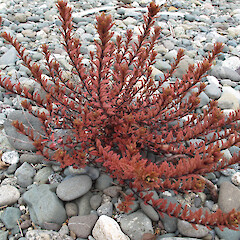Epilobium melanocaulon
Common name
willowherb
Family
Onagraceae
Flora category
Vascular – Native
Endemic taxon
Yes
Endemic genus
No
Endemic family
No
Structural class
Herbs - Dicotyledons other than Composites
NVS code
The National Vegetation Survey (NVS) Databank is a physical archive and electronic databank containing records of over 94,000 vegetation survey plots - including data from over 19,000 permanent plots. NVS maintains a standard set of species code abbreviations that correspond to standard scientific plant names from the Ngä Tipu o Aotearoa - New Zealand Plants database.
EPIMEL
Chromosome number
2n = 36
Current conservation status
The conservation status of all known New Zealand vascular plant taxa at the rank of species and below were reassessed in 2017 using the New Zealand Threat Classification System (NZTCS) – more information about this can be found on the NZTCS website. This report includes a statistical summary and brief notes on changes since 2012 and replaces all previous NZTCS lists for vascular plants.
Please note, threat classifications are often suggested by authors when publications fall between NZTCS assessment periods – an interim threat classification status has not been assessed by the NZTCS panel.
- Conservation status of New Zealand indigenous vascular plants, 2017 . 2018. Peter J. de Lange, Jeremy R. Rolfe, John W. Barkla, Shannel P. Courtney, Paul D. Champion, Leon R. Perrie, Sarah M. Beadel, Kerry A. Ford, Ilse Breitwieser, Ines Schönberger, Rowan Hindmarsh-Walls, Peter B. Heenan and Kate Ladley. Department of Conservation. Source: NZTCS and licensed by DOC for reuse under the Creative Commons Attribution 4.0 International licence.
2017 | Not Threatened
Previous conservation statuses
2012 | Not Threatened
2009 | Not Threatened
2004 | Not Threatened
Distribution
Endemic. New Zealand: North and South Islands from Rotorua and Lake Waipapa (Waikato River Hydroelectric dam) south.
Habitat
lowland to alpine. Usually riparian, in open braided river and gravelly river beds and watercourses. Also on moraines, scree slopes, and in gravel on lake margins. Rarely in urban areas, often found in the eastern South Island growing along railway tracks.
Detailed description
Much-branched, stoutly tap-rooted, erect, perennial herb forming shrublets 0.1-0.3 m tall. Branches arising from the base (rarely above). Stems purple-black, maroon (sometimes green), with dense strigulose lines decurrent from the margins of the petioles. Leaves sessible to subsessile, mostly opposite towards base, alternate in or near inflorescence, dark dull green, purple-black or maroon, midvein scarcely visible to prominently so, lateral veins not evident, 1-3 on each side of midrib; petioles if present 1-2 mm long; lamina 3-12(-20) x 1-4(-6) mm, narrowly elliptic to elliptic, apex acute (often apiculate), base attenuate, margins remotely, coarsely serrate, teeth 2-4 on each side. Inflorescence erect. Flowers erect. Ovaries 6-14 mm long, glabrous, green to purple-black, sessile or on pedicels 2 mm long. Floral tube 0.2-0.6 x 1.0-1.4 mm, glabrous. Sepals not keeled, 2-8-4.5 x 0.9-1.1 mm. Petals 5.0-6.5 x 2.3-3.0 mm, white, flushed pink after pollination, the notch 0.5-1.0 mm deep. Anthers 0.4-0.5 x 0.25-0.3 mm, yellow; filaments of the longer stamens 1.5-2.3 mm long, those of shorter ones 0.8-1.5 mm long, the anthers of the longer stamens shedding pollen directly on the stigma at anthesis. Style 2.1-2.6 mm high, white; stigma 0.8-1.9 mm x 0.45-0.9 mm, short-clavate, surrounded by the anthers of the longer stamens at anthesis. Capsules 18-38 mm long, brown, glabrous, sessile or on pedicels up to 9 mm long. Seeds 0.9-1.1 mm long, purple-brown, orange ot orange-brown usually tinged purple, obovate, finely reticulate-mamillate; coma 4.0-6.5 mm long, white, caducous.
Similar taxa
Epilobium melanocaulon is unlikely to be confused with any other Epilobium in New Zealand, indigenous or otherwise. The densely branched, erect, shrubby growth habit, and purple-black stems; coarsely toothed, dark green, purple-black or maroon leaves and dark brown capsules are diagnostic of this species.
Flowering
December - April
Flower colours
Violet/Purple, White
Fruiting
February - June
Life cycle
Minute pappate seeds are wind dispersed (Thorsen et al., 2009).
Propagation technique
An attractive species well suited to a rocky garden situation. Excellent as a pot plant for terrace situation. Inclined to be short-lived so best grown from fresh seed or cuttings and treated as an annual. In good conditions will self-establish but not inclined to be weedy like many other epilobia.
Etymology
epilobium: From the Greek epi- ‘upon’ and lobos ‘a pod’, the flowers appearing to be growing on the seed pod.
melanocaulon: Black stemmed
Attribution
Fact sheet prepared for NZPCN by P.J. de Lange (28 October 2012).Description adapted from Raven & Raven (1976) and Webb & Simpson (2001).
References and further reading
Raven, P.H.; Raven, T.E. 1976: The genus Epilobium in Australasia. New Zealand DSIR Bulletin 216. Wellington, Government Printer.
Thorsen, M. J.; Dickinson, K. J. M.; Seddon, P. J. 2009. Seed dispersal systems in the New Zealand flora. Perspectives in Plant Ecology, Evolution and Systematics 11: 285-309
Webb, C.J.; Simpson, M.J.A. 2011: Seeds of New Zealand Gymnosperms and Dicotyledons. Christchurch, Manuka Press.
NZPCN Fact Sheet citation
Please cite as: de Lange, P.J. (Year at time of access): Epilobium melanocaulon Fact Sheet (content continuously updated). New Zealand Plant Conservation Network. https://www.nzpcn.org.nz/flora/species/epilobium-melanocaulon/ (Date website was queried)







